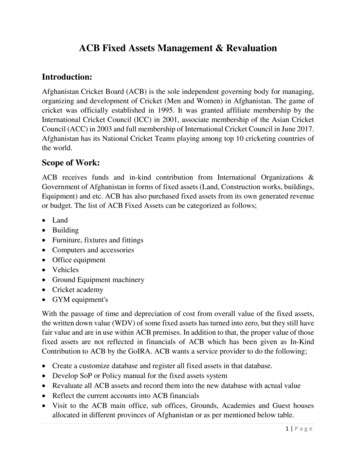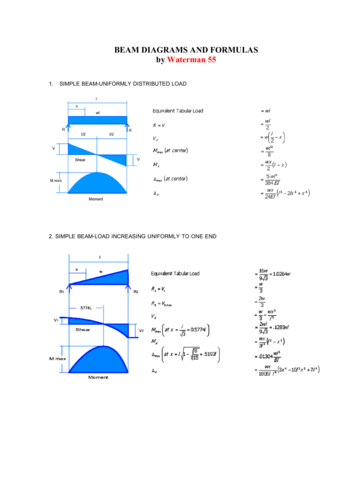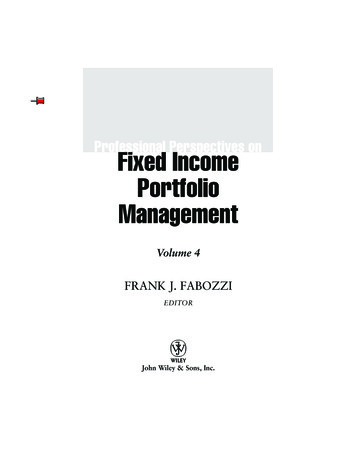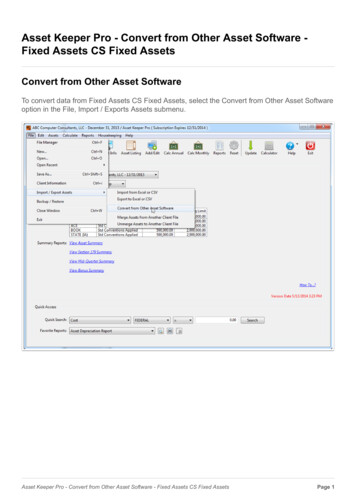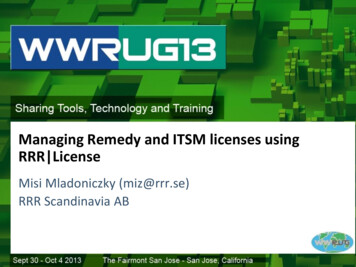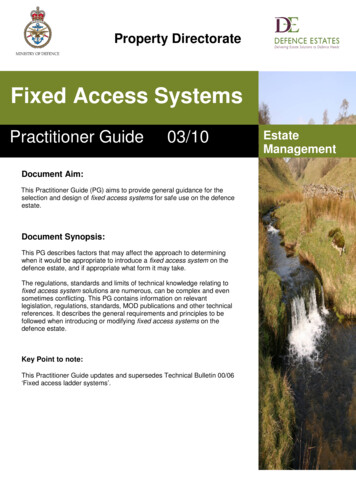
Transcription
Property DirectorateFixed Access SystemsPractitioner Guide03/10Document Aim:This Practitioner Guide (PG) aims to provide general guidance for theselection and design of fixed access systems for safe use on the defenceestate.Document Synopsis:This PG describes factors that may affect the approach to determiningwhen it would be appropriate to introduce a fixed access system on thedefence estate, and if appropriate what form it may take.The regulations, standards and limits of technical knowledge relating tofixed access system solutions are numerous, can be complex and evensometimes conflicting. This PG contains information on relevantlegislation, regulations, standards, MOD publications and other technicalreferences. It describes the general requirements and principles to befollowed when introducing or modifying fixed access systems on thedefence estate.Key Point to note:This Practitioner Guide updates and supersedes Technical Bulletin 00/06‘Fixed access ladder systems’.EstateManagement
Document InformationProperty Directorate Sponsor: Martin CoulsonDate of Issue: 25 Mar 10Contact if different from above Sponsor: Principal Structures, Professional and Technical Services,Defence Estates, Kingston Road, Sutton Coldfield. B75 7RLMilitary 94421 2005 Civil 0121 311 2005Who should read this: CEstOs, Top Level Budget Holders, Defence Estates Advisors, EstateManagers, DE Facilities Managers and Property Managers/Site Estate Representatives, PropertyManagement Works Services (including the legacy work of EWCs/WSMs), DE Health and SafetyTeams, DE Project Managers and any other person who is responsible for the planning, design,installation, maintenance and use of fixed access systems on the defence estate.When it takes effect: ImmediatelyWhen it is due to expire: 24 Mar 15Equality And Diversity Impact AssessmentThis policy has been Equality and Diversity Impact Assessed in accordance with the Department’s Equality andDiversity Impact Assessment Tool against:Part 1 Assessment Only (no diversity impact found).Document ControlDistributionDocument Name:Version No:Version Date:Author:Reviewed By:Fixed Access Systems1.001 January 2010Structures Section, Professional and Technical Services, DEPrincipal StructuresReview Date:01 January 2015Version ControlDate IssuedVersionAuthorReason for ChangeRelated Documentse.g.Other JSP leaflets, etce.g.Other practitioner guidese.g. EBMS ProcessesJSP375; Vol 2; Leaflet 7 and Vol 3; Chapter 7PG 09/08 and PG 10/082.5.4.82
Contents1Foreword42Legislation, Regulations, Standards, MOD publications and other References63Fixed Access Systems – Technical Guidance3.1Introduction83.2General Principles83.3Domestic and Industrial Buildings, Machinery and Plant83.4Masts, Towers and other Tall Structures94Permanently Installed Fall Protection Systems105Anti-Climb Devices113
1Foreword1.1This Practitioner Guide (PG) provides guidance for the selection and design of fixed accesssystems, as typically found on domestic and industrial buildings, machinery and plant, masts,towers and other tall structures on the Ministry of Defence (MOD) estate. It is applicable to thewhole of the defence estate unless agreed otherwise, for example, as per host nationagreements, and as in accordance with the policy of the Secretary of State.1.2For the purpose of this PG the definition of a fixed access system shall include any combinationof vertical fixed ladders (75 degrees or greater), companion way ladders (65 to 75 degrees),associated access, work or rest platforms, high level walkways, associated handrails andbalustrades and associated fixed fall arrest systems. This PG applies to fixed access systemsthat are found on any domestic buildings (e.g. living accommodation), industrial buildings (e.g.hangars), machinery, plant, masts, towers, other tall structures and any other permanent facilityor installation that is found on the defence estate.1.3A stairway in a permanent workplace, although a type of access, does not constitute work atheight and for the purpose of this PG is excluded from the definition of a fixed access system. Afire escape ladder or access system is also excluded within the context of this PG.1.4The overriding requirement of legislation is that work is not to be carried out at height where it isreasonably practicable to carry out the work safely other than at height. It is important to alwaysbear in mind that access or egress, except by a stairway in a permanent workplace, to a place ofwork where a person could fall a distance liable to cause personal injury would constitute workat height.1.5This PG is intended for use primarily by designers, specifiers, users and anyone else withresponsibility for the procurement and through-life management of fixed access systems.1.6This PG does not reproduce technical criteria that already exist in UK legislation or standards. Itaims to describe the overall objectives to be achieved and the principles to follow that will allowa designer, specifier, user and anyone else with responsibility for the procurement and throughlife management of fixed access systems to achieve practical and safe solutions within theparameters of current legislation, technical standards and achieving value for money.1.7The defence estate has approximately 3000 masts and towers, incorporating various forms offixed access systems and a much greater number of fixed access systems as found on domesticbuildings, industrial buildings, machinery, plant and other tall structures.1.8A fixed access system on the defence estate may constitute a ‘Restricted High Place’ (RHP) asdefined in the MOD Health and Safety Handbook (Joint Services Publication 375; Volume 3;Chapter 7 Working at Height on Restricted High Places). Where a high place has beenassessed to have a risk of a fall liable to cause personal injury, it may be designated as an RHPby the Authorising Engineer (Working at Height). Access to an RHP is to be controlled under thesafe system of work as detailed in Chapter 7.1.9At the time of preparation of this PG, it is noted that UK technical standards recommendprovision for protection from falls in the form of ‘caged’ or ‘hooped’ ladders. However, researchsponsored by the Health and Safety Executive (Research Report 258) appears to question thesuitability of this provision. In all cases, legislation takes precedence, and it is consideredincumbent upon the designer or specifier, so far as is reasonably practicable, to monitor thecurrent debate on the subject in order to avoid foreseeable risks in the choice of such provisionfor fall protection.1.10This PG is to support MOD’s statutory duties under the Health and Safety at Work etc Act 1974and in particular the Management of Health and Safety at Work Regulations and The Work atHeight Regulations. The guidance is intended for use on new structures but can be applied toexisting structures as determined by risk assessment.4
1.11For MOD Establishments occupied by the United States Visiting Forces (USVF), theresponsibility is jointly held by the USVF and DE (USF). At base level this joint-managedorganisation is to take appropriate action to note the contents of this PG. Where this PGcontains procedures which differ significantly from USVF practice, a DE (USF) Code of Practicesection is to be appended.1.12No work involving expenditure on any MOD account is to be entered into without authority fromthe appropriate MOD officer for that location or facility.5
2Legislation, Regulations, Standards, MOD Publications and otherReferencesThe following Legislation, Regulations, British and International Standards are included forreference purposes. The list is not exhaustive. The reader must be satisfied that any referencemade to the actual document is to be the most up to date version.2.1Statutory LegislationHealth and Safety at Work etc Act 1974Health and Safety at Work etc (NI) Order 1978Occupiers’ Liability Act 19842.2Statutory RegulationsManagement of Health and Safety at Work Regulations 1999The Construction (Design and Management) Regulations 2007The Work at Height Regulations 2005The Work at Height (Amendment) Regulations 2007The Work at Height Regulations (Northern Ireland) 2005The Work at Height (Amendment) (Northern Ireland) Regulations 2007The Lifting Equipment and Lifting Operations Regulations 1998The Provision and Use of Work Equipment Regulations 1998The Building Regulations 2000 (Approved Document K)2.3National StandardsBS 4211:2005 Specification for permanently fixed laddersBS EN ISO 14122 Safety of machinery. Permanent means of access to machinery (4 parts)BS 6399-1:1996 Loadings for buildings. Code of practice for dead and imposed loadsBS 5395-1:2000 Stairs, ladders and walkways. Code of practice for the design, construction andmaintenance of straight stairs and windersBS 5395-3:1985 Stairs, ladders and walkways. Code of practice for the design of industrial typestairs, permanent ladders and walkwaysBS 8437:2005 Code of Practice for selection, use and maintenance of personal fall protectionsystems and equipment for use in the workplaceBS EN 353 Personal protective equipment against falls from a height (2 parts)2.4MOD PublicationsJSP 375 MOD Health and Safety Handbook6
JSP 569 Working at Height Personal Protective EquipmentPractitioner Guide 09/08 Masts and Towers - Design and AppraisalPractitioner Guide 10/08 Masts and Towers - Condition Inspection2.5Reference PublicationsFactory Stairways, Ladders and Handrails including Access Platforms and Ramps, Publication105, 7th Edition, The Engineering Equipment and Materials Users’ Association ISBN 0 85931154 6Health and Safety in Roof Work, HSG 33, Health and Safety Executive ISBN 978 0 7176 6250 0Communication Structures, Brian W. Smith BA MS FREng CEng FICE FIStructE FASCE, 2007,Thomas Telford Publishing, London ISBN 978 0 7277 3400 62.6Research PublicationsResearch Report 258, Preliminary Investigation into the fall-arresting effectiveness of laddersafety hoops, D Riches BSc (Hons), 2004, HSE Books ISBN 0 7176 2885 X7
3Fixed Access Systems – Technical Guidance3.1Introduction3.1.1 All fixed access systems are to be designed suitable for their intended purpose. Their type, formand function are selected following a design risk assessment and taking into considerationrelevant standards and regulations. Factors to be considered in the design risk assessmentinclude type of structure, location, environment, purpose, intended users (including theircompetence in climbing) and cost.3.1.2 The defence estate covers broad categories of buildings and installations, for example domesticdwellings, industrial buildings (hangars, workshops etc) and machinery and plant installations(internal or external). Standards for fixed access systems are readily available for these types ofbuildings and installations.3.1.3 For facilities such as masts, towers and other tall wind sensitive structures, there are at present,no specific national standards, and ‘industry practice’ is a specialist area where technicalsolutions for fixed access systems are varied. A competent person (as defined in PractitionerGuide 09/08) is required to determine the most appropriate fixed access system solutions.Technical guidance on the design and provision of fixed access systems on masts, towers andother tall wind sensitive structures is provided in section 3.4.3.2General Principles3.2.1Fixed access systems on the defence estate, whether proposed or existing, are subject to theguidance provided in this PG, for their procurement and through-life management.3.2.2For new-build structures, a stairway is to be given preference as far as reasonably practicable,thus avoiding the need to work at height.3.2.3Fixed access systems are to be assessed in accordance with JSP 375; Volume 3; Chapter 7 inrespect to safety during work at height. If a fixed access system forms part of a Restricted HighPlace (RHP), the provisions of Chapter 7 shall apply for its safe use and access. In all cases theappropriate Authorised Person (Working at Height) shall be consulted initially.3.2.4Where it is deemed reasonably practicable, following a risk assessment, to introduce a newfixed access system or modify an existing system, then the fixed access system shall beselected and designed taking account of factors including, amongst others, the intendedfrequency of use, the facility, the location, the minimum level of competency of personnelrequired to access it and all other associated hazards.3.2.5The type, materials and dimensional arrangements of the fixed access system shall comply withall relevant UK regulations and British standards, section 2 refers.3.3Domestic and Industrial Buildings, Machinery and Plant3.3.1 Domestic buildings are to have stairways incorporated into the design where a change in floorlevel is required, and the particular requirements of The Building Regulations 2000 (ApprovedDocument K) shall apply.3.3.2 Dependent on the form of the domestic or industrial building, machinery or plant installationsand the associated design risk assessment, the designer may propose a fixed access systemincluding vertical ladders, platforms and handrails as determined by the following leadreferences: The Building Regulations 2000 (Approved Document K) BS 5395-1:2000 Stairs, ladders and walkways. Code of practice for the design, constructionand maintenance of straight stairs and winders8
3.4 BS 5395-3:1985 Stairs, ladders and walkways. Code of practice for the design of industrialtype stairs, permanent ladders and walkways BS EN ISO 14122 Safety of Machinery. Permanent means of access to machinery (4 parts) Factory Stairways, Ladders and Handrails including Access Platforms and Ramps,Publication 105, 7th Edition, The Engineering Equipment and Materials Users’ Association.Masts, Towers and other Tall Structures3.4.1 Dependent on the structural form of the mast or tower and the associated design riskassessment, the designer may propose a fixed access system includi
1.2 For the purpose of this PG the definition of a fixed access system shall include any combination of vertical fixed ladders (75 degrees or greater), companion way ladders (65 to 75 degrees), associated access, work or rest platforms, high level walkways, associated handrails and balustrades and associated fixed fall arrest systems. This PG applies to fixed access systems
